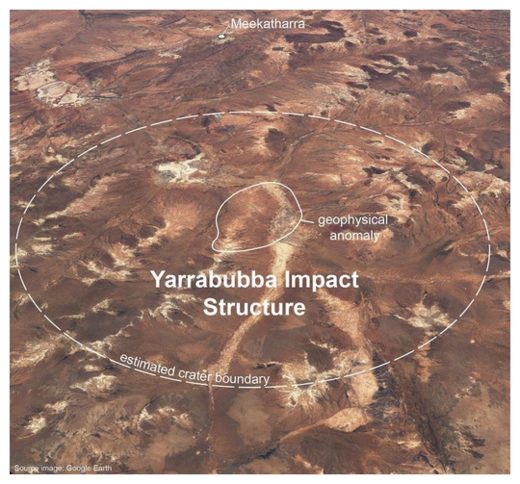
© Google Earth
has been
presented in the journal
Nature Communications.Dated at 2.229 billion years, 200 million years older than the next known asteroid strike at Vredefort Dome in South Africa, the impact coincides with the end of a deep freeze known as early
Snowball Earth and could have contributed to the ice thawing.
After this time period there are no rock records of large glacial deposits for 400 million years, says lead author Timmons Erickson from NASA Johnson Space Centre, Houston, US.
"Because of this, we were interested in seeing the role that an impact crater could have had during a time of global glaciations and whether an impact could release enough water vapour, a strong greenhouse gas, to significantly warm the planet."
Calculating the impact of the meteorite on an icy continent, they found that it could have sent half a trillion tonnes of water vapour into the atmosphere, thereby contributing to the global ice melt.
This highlights why the timing of "extraterrestrial bombardment" is important, as the authors write, so its effects on the Earth's environment can be understood.
To date, the historical impact record is fragmented, making it hard to understand how meteorites affect the planet - apart from the
Chicxulub asteroid that triggered the last mass extinction and could explain the ocean's acidification.
"There are still lots of gaps in the terrestrial impact record; while we know of thousands of impact craters on the Earth's moon, there are only about 190 recognised impact structures on Earth," says Erickson.
Craters gradually disappear with time through erosion and tectonic movements, making it challenging to find old craters at all, says co-author Aaron Cavosie from Curtin University, Western Australia.
This is the case with Yarrabubba, he adds. "The landscape is barren, but not empty. Bits of rocks exposed near the centre of the formerly giant crater hold the microscopic clues to the past violence that occurred 2.229 billion years ago."
Added to that, geoscience relies heavily on fieldwork, he says, "where observations are made standing in the burning sun, flies buzzing in your ears, dust on your boots.
"The analytical firepower is what delivers the result, but it starts with a geologist who says, 'hey, that rock looks interesting'."
Once the rocks are selected, advanced lab methodologies are applied - in this case, Cavosie says, "electron backscatter diffraction was used to identify the specific crystals that had been age-reset through analysis of their microscopic orientation".
Then they used mass spectrometry to measure "isotopic clocks" contained by uranium and lead in the rocks.
Trace amounts of uranium decays to lead over time at a known rate, Cavosie explains, so their disruption by a meteorite helps to pinpoint the time it struck.
"When a giant impact forms, rocks in the centre get hot enough to cause the atomic bonds in the mineral to break open and reform. This process evacuates the accumulated lead. After the impact, lead starts collecting again."
The breakthrough at Yarrabubba, part of Western Australia's rich geological heritage, is a "once-in-a-generation type of discovery," says Cavosie, the last dating being the 2.02 billion-year-old Vredefort impact 25 years ago.
"What the Yarrabubba discovery shows clearly is that it is worth the effort to continue to search the geological record for old craters.
"It helps planetary scientists recreate the formative years of Earth's history and write some of the earliest pages in the history book."
Reader Comments
IE; The Safire project has shown the latter as a practical plausibility - along with transmutation of elements.
Louis Hissink posits a lot of questions - a geologist who opened to Aboriginal myths of the 'Rainbow Serpent' as associated with - eg diamond deposits
[Link]